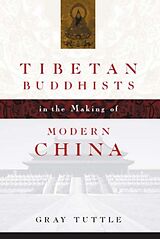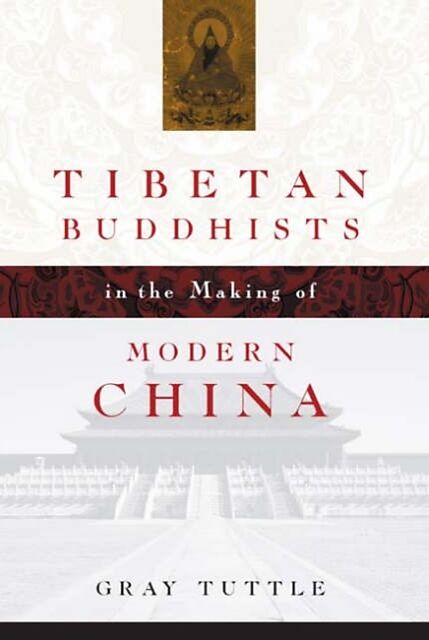Tibetan Buddhists in the Making of Modern China
Einband:
Fester Einband
EAN:
9780231134460
Untertitel:
Englisch
Genre:
Geschichte
Autor:
Gray Tuttle
Herausgeber:
Columbia University Press
Anzahl Seiten:
352
Erscheinungsdatum:
26.04.2005
ISBN:
978-0-231-13446-0
Informationen zum Autor Gray Tuttle Klappentext Over the past century and with varying degrees of success! China has tried to integrate Tibet into the modern Chinese nation-state. In this groundbreaking work! Gray Tuttle reveals the surprising role Buddhism and Buddhist leaders played in the development of the modern Chinese state and in fostering relations between Tibet and China from the Republican period (1912-1949) to the early years of Communist rule. Beyond exploring interactions between Buddhists and politicians in Tibet and China! Tuttle offers new insights on the impact of modern ideas of nationalism! race! and religion in East Asia.After the fall of the Qing dynasty in 1911! the Chinese Nationalists! without the traditional religious authority of the Manchu Emperor! promoted nationalism and racial unity in an effort to win support among Tibetans. Once this failed! Chinese politicians appealed to a shared Buddhist heritage. This shift in policy reflected the late-nineteenth-century academic notion of Buddhism as a unified world religion! rather than a set of competing and diverse Asian religious practices. While Chinese politicians hoped to gain Tibetan loyalty through religion! the promotion of a shared Buddhist heritage allowed Chinese Buddhists and Tibetan political and religious leaders to pursue their goals. During the 1930s and 1940s! Tibetan Buddhist ideas and teachers enjoyed tremendous popularity within a broad spectrum of Chinese society and especially among marginalized Chinese Buddhists. Even when relationships between the elite leadership between the two nations broke down! religious and cultural connections remained strong. After the Communists seized control! they continued to exploit this link when exerting control over Tibet by force in the 1950s. And despite being an avowedly atheist regime! with the exception of the Cultural Revolution! the Chinese communist government has continued to recognize and support many elements of Tibetan religious! if not political! culture.Tuttle's study explores the role of Buddhism in the formation of modern China and its relationship to Tibet through the lives of Tibetan and Chinese Buddhists and politicians and by drawing on previously unexamined archival and governmental materials! as well as personal memoirs of Chinese politicians and Buddhist monks! and ephemera from religious ceremonies. Zusammenfassung Reveals the surprising role Buddhism and Buddhist leaders played in the development of the modern Chinese state and in fostering relations between Tibet and China from the Republican period (1912-1949) to the early years of Communist rule. This work offers insights on the impact of modern ideas of nationalism! race! and religion in East Asia. Inhaltsverzeichnis Map: Tibet and Tibetan Buddhist Activity in ChinaIntroductionCountering Nationalist HistoriographyTransitions: Making National! Going Global1. Imperial TraditionsTraditions Linking Tibetan Buddhists and Dynastic RulersTibetan Buddhist Intermediaries at the Qing CourtTraditions That Divided Tibet from China Proper2. Global Forces in Asia (1870s-1910s)Western Imperialist Commercial Interests in TibetChinese Nationalist Strategies: Designs on Tibet and the Tibetan ResponseRacial Ideology in China3. Buddhism as a Pan-Asian Religion (1890s-1928)The Shared Interests of Chinese and Tibetan BuddhistsThe Origins of Chinese Interest in Tibetan Buddhist Teachers and PracticesTibetan Lamas Teach in ChinaChinese Monks Study in Tibet4. Overcoming Barriers Between China and Tibet (1929-1931)Barriers to Chinese Studying Tibetan BuddhismForging New Links: Lamas Assist Chinese MonksSichuan Laity Elicits Government InvolvementThe Political Monk: Taixu5. The Failure of Racial and Nationalist Ideologies (1928-1932)The Politicization of Lamasí Roles in ChinaSecular Educational InstitutionsSino-Tibetan Secular Dialogue on Chinese TermsFailed Rhetoric: Tibetan Autono...
Autorentext
Gray Tuttle
Klappentext
Over the past century and with varying degrees of success, China has tried to integrate Tibet into the modern Chinese nation-state. In this groundbreaking work, Gray Tuttle reveals the surprising role Buddhism and Buddhist leaders played in the development of the modern Chinese state and in fostering relations between Tibet and China from the Republican period (1912-1949) to the early years of Communist rule. Beyond exploring interactions between Buddhists and politicians in Tibet and China, Tuttle offers new insights on the impact of modern ideas of nationalism, race, and religion in East Asia.After the fall of the Qing dynasty in 1911, the Chinese Nationalists, without the traditional religious authority of the Manchu Emperor, promoted nationalism and racial unity in an effort to win support among Tibetans. Once this failed, Chinese politicians appealed to a shared Buddhist heritage. This shift in policy reflected the late-nineteenth-century academic notion of Buddhism as a unified world religion, rather than a set of competing and diverse Asian religious practices. While Chinese politicians hoped to gain Tibetan loyalty through religion, the promotion of a shared Buddhist heritage allowed Chinese Buddhists and Tibetan political and religious leaders to pursue their goals. During the 1930s and 1940s, Tibetan Buddhist ideas and teachers enjoyed tremendous popularity within a broad spectrum of Chinese society and especially among marginalized Chinese Buddhists. Even when relationships between the elite leadership between the two nations broke down, religious and cultural connections remained strong. After the Communists seized control, they continued to exploit this link when exerting control over Tibet by force in the 1950s. And despite being an avowedly atheist regime, with the exception of the Cultural Revolution, the Chinese communist government has continued to recognize and support many elements of Tibetan religious, if not political, culture.Tuttle's study explores the role of Buddhism in the formation of modern China and its relationship to Tibet through the lives of Tibetan and Chinese Buddhists and politicians and by drawing on previously unexamined archival and governmental materials, as well as personal memoirs of Chinese politicians and Buddhist monks, and ephemera from religious ceremonies.
Zusammenfassung
Reveals the surprising role Buddhism and Buddhist leaders played in the development of the modern Chinese state and in fostering relations between Tibet and China from the Republican period (1912-1949) to the early years of Communist rule. This work offers insights on the impact of modern ideas of nationalism, race, and religion in East Asia.
Inhalt
Map: Tibet and Tibetan Buddhist Activity in China Introduction Countering Nationalist Historiography Transitions: Making National, Going Global 1. Imperial Traditions Traditions Linking Tibetan Buddhists and Dynastic Rulers Tibetan Buddhist Intermediaries at the Qing Court Traditions That Divided Tibet from China Proper 2. Global Forces in Asia (1870s-1910s) Western Imperialist Commercial Interests in Tibet Chinese Nationalist Strategies: Designs on Tibet and the Tibetan Response Racial Ideology in China 3. Buddhism as a Pan-Asian Religion (1890s-1928) The Shared Interests of Chinese and Tibetan Buddhists The Origins of Chinese Interest in Tibetan Buddhist Teachers and Practices Tibetan Lamas Teach in China Chinese Monks Study in Tibet 4. Overcoming Barriers Between China and Tibet (1929-1931) Barriers to Chinese Studying Tibetan Buddhism Forging New Links: Lamas Assist Chinese Monks Sichuan Laity Elicits Government Involvement The Political Monk: Taixu 5. The Failure of Racial and Nationalist Ideologies (1928-1932) The Politicization of Lamasí Roles in China Secular Educational Institutions Sino-Tibetan Secular Dialogue on Chinese Terms Failed Rhetoric: Tibeta…

Leider konnten wir für diesen Artikel keine Preise ermitteln ...
billigbuch.ch sucht jetzt für Sie die besten Angebote ...
Die aktuellen Verkaufspreise von 6 Onlineshops werden in Realtime abgefragt.
Sie können das gewünschte Produkt anschliessend direkt beim Anbieter Ihrer Wahl bestellen.
Loading...
Die aktuellen Verkaufspreise von 6 Onlineshops werden in Realtime abgefragt.
Sie können das gewünschte Produkt anschliessend direkt beim Anbieter Ihrer Wahl bestellen.
| # | Onlineshop | Preis CHF | Versand CHF | Total CHF | ||
|---|---|---|---|---|---|---|
| 1 | Seller | 0.00 | 0.00 | 0.00 |
